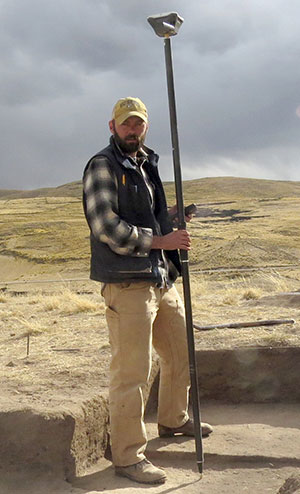UW Professor’s Research on 9,000-Year-Old Burial Site Suggests Women Hunted Big Game
Published November 27, 2023

University of Wyoming Assistant Professor Randy Haas’ research on the 9,000-year-old Wilamaya Patjxa burial site in Peru suggests that women might have hunted big game.
During archaeological excavations in the Andes Mountains in 2018, a team of archaeologists and Indigenous collaborators discovered an adult individual interred 9,000 years ago with a large-mammal hunting toolkit that included six projectile points.
“At the time, we assumed the individual was a male hunter,” says Haas, of UW’s Department of Anthropology. “However, osteological and proteomic analysis later revealed the male hunter was actually female.”
This unexpected finding generated a lot of media interest, he notes, because it suggests -- contrary to prevailing theories -- that both women and men participated in large-mammal hunting in early human communities in the Americas. The research recently was published in the journal Scientific Reports.
Haas teamed up with the University of Louisville’s Ashley Smallwood, who specializes in lithic usewear analysis -- a technique for examining microscopic wear patterns on stone tools to identify their function. They did further research into whether the projectile points at Wilamaya Patjxa were, in fact, projectile points.
“They could have been more like kitchen knives used in domestic activities, or they may have been fashioned specifically as funerary objects to honor the deceased,” Haas says.
The two researchers traveled to the Peruvian Andes with a microscope and laser scanner to examine the artifacts. After further inspection, it turned out that all of the supposed projectile points were indeed projectile points and showed the signs of projectile wear.
“Interestingly, some of the projectile points also show signs of knife wear. The objects were multitools,” Haas says.
In the end, they concluded that the projectile points associated with the female individual were not just kitchen knives, nor were they strictly funerary objects. They were projectile points used to hunt large mammals.
The findings indicated that both females and males were large-mammal hunters in some times and places in the past.
“The widespread idea that hunting is for men and the home is for women does not apply to all times and places,” Haas says. “Labor division, instead, depends on economic, ecological and social conditions.”
Haas is an archaeologist who investigates human behavior in forager societies of the past to better understand human behavior in the present. His topics of interest include forager diets, mobility, technology, inequality, cooperation, gender and diversity. Haas leads archaeological excavations and survey projects in the Andes and mountain regions of western North America.
He also specializes in quantitative comparative approaches that integrate large datasets across North and South America.
To learn more about Haas’ research, email him at whaas@uwyo.edu.

